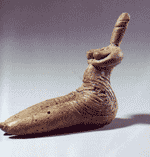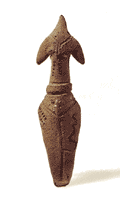BurialsEarly Burials: C-Group and A-GroupThe A-Group:The A-Group was a culture in Lower Nubia that flourished from about 3500 BC to 2900 BC.1 As mentioned in the history section,2 recent research has indicated that the A-Group have originated from the Dongola Reach area of Sudan. The A-Group graves included luxury items indicating the presence of a privilaged class. In one of these grave, the deceased was found wrapped in hides and accompanied with a fan of ostrich feathers, a leather cap, a wooden bowl, and some other items. Graves that belonged to lower classes, on the other hand, are abundant.
The grave sizes in the large A-Group cemetery of Wadi Halfa, in Sudan, ranged between 3.54 m2 and 1.62 m2. Most of the A-Group burials, excavated at Sayala, Qustul, and elsewhere, were positioned on sub-rectangular or oval pits. Graves of privilaged individuals were roofed with dried mud; each was topped with a stone slab. The combination of dried mud and stone helped protect the goods inside. The bodies were usually found in the straight position with the hands away from the face indicating the existence of unique cultural traditions. At el-Kadada in Sudan,3 goat skeletons were abundantly uncovered inside graves indicating that the A-Group practiced herding as a life style.
The most common and astounding type of findings for this culture is pottery. Pottery is usually found placed behind the head of the deceased. Evidence for Ritual ceremonies were found. Breaking pottery and sacrificing animals on top of graves were among the rituals of the A-Group that continued through the ancient history of Sudan. Jars with black-colored tops and incised designes, and bowls with cross-hatchings and geometric shapes, are among the most common types of A-Group pottery decorations. Imported pottery from southern Egypt, Lower Egypt, and Syria were found in A-Group cemeteries. Lower Egyptian artefacts, on the other hand, were rarely found in A-Group graves. At Qustul, elite graves were excavated in considerable numbers. The most important finding has been an incense burner dated to about 3000 BC.4 The burner has the figure of an individual riding a boat and wearing a fake beard. This type of clothing was unique to the pharaohs of Kush. The incese burner constitutes the earliest dated finding for the existence of kingship in Lower Nubia. At El Ghaba, Kadero, Sayala, and various other sites in Sudan, wealthy A-Group cemeteries where excavated and grave goods were abundantly found.5 The C-Group:
Around 2300 BC, a unique culture known archeologically as the C-Group,6 settled in Lower Nubia. Archeology indicates that the group has originated from the Dongola Reach area of Sudan.7 What makes this culture particularily important, is the fact that it was contemporary with the kingdom of Kush at Kerma. Studies on the C-Group provided archeologists with valuable information on the northerly cultural expansion of the Kerma culture. Our information on the group mainly comes from the cemeteries. The C-Group people were unique for building circular superstructures made out of cut masonry and filled with sand and gravel. Occasionally, C-Group graves included a mud-brick chapel with deposits of sacrificed animals. In most of the C-Group burials, the bodies were positioned facing east. In the Middle kingdom the orientation of the head was changed to west. A cylindrical wall built of stones and dried-mud, and roofed with hay, distinguished some C-Group graves. During the Second Intermediate period a mud-brick chapel was sometimes added to one side of the structure. C-Group pottery designed with incised and complex designs is closely similar to the Khartoum Neolithic pottery. The black topped and red polished pottery, made in the traditional style of the Kerma pottery, shows that the culture was inherintly Sudanese. Egyptian pottery was also found in C-Group graves indicating trade. In 2000 BC, Egypt conquered Lower Nubia, and therefore the C-Group. This explains the reason no weapons were found in C-Group graves. By 1550 BC, the culture has mysteriously disappeared.
Edited: Mar. 2009. |


